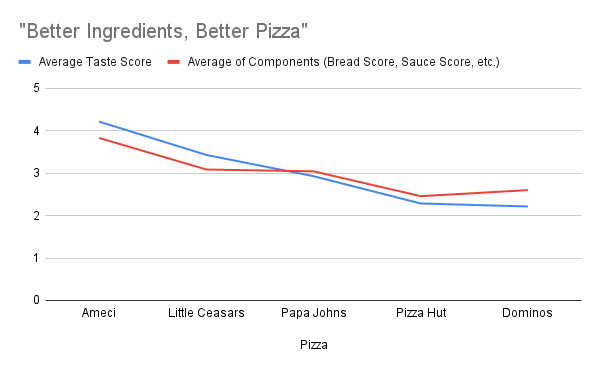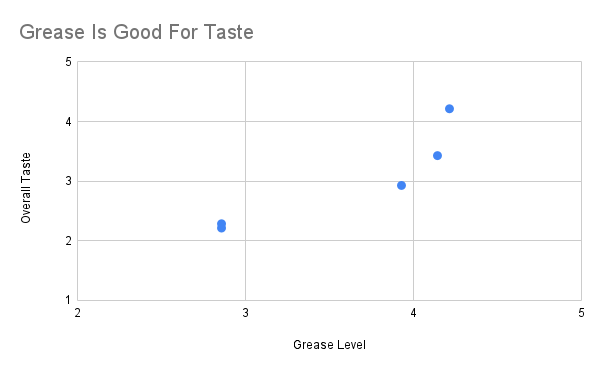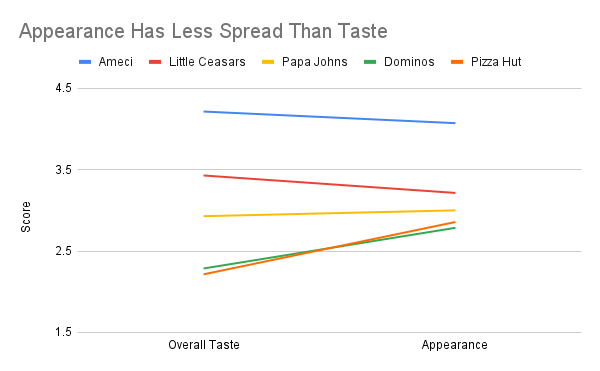- Published on
Pizza Taste Test
- Authors

- Name
- Robert Claus
Abstract
For a long time, I have been curious about how different pizzas compare side-by-side. Most pizza is ordered as a full meal, so sampling two different pizza chains at the same time is extremely rare. This is obviously true for something like a sit-down restaurant as well, but at least those have additional factors like ambiance that add to the experience. The experience for delivery pizza chains is the same since it is at home, and so directly comparing the food itself is more interesting.
Experimental Setup
We ordered pizza from five different pizza chains to evaluate which pizza was best. The pizza chains were Pizza Hut, Dominos, Papa Johns, Ameci, and Little Ceasars. Ameci is a chain local to Los Angeles, but it has 40+ locations so we considered it large enough to include in the comparison.
Little Ceasars has a reputation for low quality ready-made pizzas. None of the judges wanted to give those pizzas a chance, so we gave it a handicap by ordering their "deep dish" style instead. All other pizzas were large and ordered using default settings with pepperoni as the only topping.
Participants tried all five pizzas and rated them on a 5 point scale for Overall Taste, Appearance, Bread, Cheese, Sauce, Pepperoni, and Greasiness. Greasiness was considered a negative attribute by most participants during ratings, and hence generally excluded from any "average" calculations. There were 7 participants, 6 of which were male. All individuals had grown up in middle class suburban communities. The participants were approximately 25 to 35 years old.
Controlling Variables
In an effort to make the comparison as fair as possible, we did our best to avoid too many variables outside of the pizza itself. All pizzas were ordered ahead of time to be ready at the same time. Pizzas were picked up as carry-out orders by different drivers at the same time to minimize timing differences. All pizzas were set out at the same table. Participants were encouraged to eat the pizzas in different orders.
A factor we were unable to control for was pizza price. The chains we ordered from had extraordinary variance in price depending on what coupons were available. For example, we were able to get a $9 pizza from Dominos with a coupon always available on their website, whereas we paid over $20 for a single large pizza at Pizza Hut due to lack of coupon. This degree of price discrimination seems quite absurd and likely preys on classes of customers that aren't as aware of these practices. Due to the seemingly arbitrary nature of the prices, we did not include them in our analysis.
Insights
A more local chain turned out winning for us. Ameci pizza has about 40 locations compared to thousands for the other chains.

Anecdotally we all remembered Dominos and Pizza Hut being much better than they are now. Our theory was that they had to cut quality to keep prices fairly consistent through the recent inflation period. We assume Ameci was more willing to invest in quality due to leadership being closer to day-to-day operations.
Greasiness correlated very well with taste preference. We all complained about how greasy certain pizzas were, but the final scores reflected a preference for them. This was surprising, but likely explained why pizza tends to be so greasy. Knowing this makes me more forgiving of greasy pizzas - at least it's likely to be deliberate and based on research.

When we look at the variance across pizza chains, it's interesting that "Appearance" didn't differ too much. On our 5 point scale, the average appearance score only ranged about 1 point. This is compared to about 2 points for overall taste.

This result is interesting because it implies that most pizza places know how to make a pizza look appetizing, but not necessarily make it taste good. In a sense, this implies chains are better at advertising than actually delivering quality. It also speaks to the incentives they have - it's more important to sell pizza than end up with happy customers.